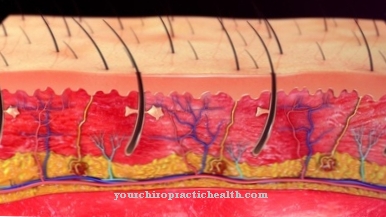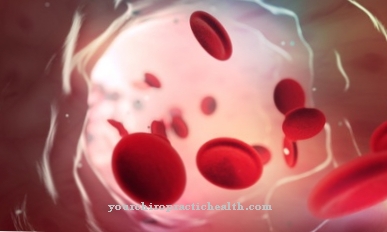Repolarization is the regression of a cell that has previously built up an action potential through a stimulus. The resting membrane potential of the cell is restored.
What is repolarization?

The term repolarization describes the restored resting potential of a cell, especially a nerve cell, after an action potential through redistribution of ions on the cell membrane.
The course of an action potential can be divided as follows:
1) resting potential,
2) exceeding the threshold potential,
3) depolarization,
4) repolarization and
5) hyperpolarization.
The membrane potential is around -70mV in the resting potential.
Function & task
A defined threshold value (- 50mV) must be exceeded on the axon hill so that the course of action can be started. If this value is not reached, there is no action potential and the incoming stimuli are not passed on. According to the “all or nothing principle”, either an action potential occurs when this threshold value is exceeded via the axon or no reaction is triggered.
With the depolarization, the action potential runs over the axon. When the corresponding channels (Na +) are opened, Na + ions flow from the outside into the interior of the axon. The so-called overshoot, a polarization reversal, takes place. The intracellular area is now positively charged.
Repolarization follows the depolarization. The opened K + channels are the prerequisite for the potassium to diffuse out of the positively charged cells. This process takes place within a short time due to the voltage difference. The voltage difference results from the positively charged cell interior and the negatively charged cell exterior. As a result of this repolarization process, the tension in the cell interior drops again. With the hyperpolarization, the voltage drops below the original resting potential.
After the repolarization, the channels responsible for reducing the voltage (Na +) have closed again, so that no new action potential is possible in this phase. This rest period is called the refractory period. The sodium-potassium pump regulates the voltage field back to the initial value of 70mV. The axon of the nerve cell is now ready for the next action potential.
If the heart is affected by repolarization, this process causes considerable discomfort. The heart is an independent and autonomous organ with a fine system of triggered and distributed waves of excitation. This vital organ has a large number of myocardial cells that are activated to contract on the basis of a schedule that is optimized in terms of time and space. As the physiological and primary pacemaker of the heart (pacemaker), the sinus node in the right atrium sets the pace, similar to a conductor. From this point the conduction of action potentials takes place via the conduction system and the heart muscle.
During repolarization, the inside of the cell is positively charged compared to the external medium. The original ion distribution is now restored by the sodium-potassium pump. The most common complaints occur in the form of primary and early repolarization. It is a disturbed process in which the state of excitement of the heart can no longer be broken down regularly. In the case of right hypertrophy with repolarization disorders, incoming stresses in the right part of the heart are no longer regularly reduced.
The heart consists of a chamber and an upstream atrium on the right and left sides. The oxygen depleted and used blood first flows through the left atrium. From there it takes its way to the right ventricle and from there it is pumped into the lungs, where it is supplied with new oxygen. The left ventricle is enlarged with thickened heart walls, which results in increased expenditure of force.
The right heart valve is the "gateway from the right ventricle to the lungs". This no longer works normally and does not open to allow the blood to pass through. There is pulmonary valve stenosis. Because the heart valve is not open normally, the blood flows back into the chamber and not into the pulmonary artery as intended. There is a congestion there due to the blood no longer flowing normally, which means that the heart uses more pumping power and increases in volume.
The heart is an electric pump because the heart muscles have to constantly draw electrical stimuli in order to trigger a contraction of the heart muscles and thus guarantee regular blood flow. After the state of excitement, however, the heart must be put back into a resting phase, the state of repolarization, in order to reduce the incoming voltages so that it is not overstrained. Only when a state of excitement has been regularly broken down do the heart muscles begin to build up a new state of excitement. However, if this rest phase lasts too long, the regular repolarization state is disturbed and the heart no longer works normally. This condition can cause a variety of symptoms, from mild cardiac arrhythmias to ventricular fibrillation and sudden cardiac death.
Many patients are affected by early repolarization, some also by idiopathic (unfounded) ventricular fibrillation. Most ECG findings are normal and only in isolated cases are repolarization disorders responsible for life-threatening arrhythmias.
The clinical findings of early repolarization do not yet allow a conclusive identification of high-risk groups at risk. The line between a non-life-threatening repolarization disorder and life-threatening ventricular fibrillation is thin. The most common causes are a genetic background and secondary factors such as age, lifestyle, the autonomic nervous system and, in individual cases, acute ischemia. Medicines can also trigger cardiac arrhythmias due to repolarization.
You can find your medication here
➔ Medicines for paresthesia and circulatory disordersIllnesses & ailments
Doctors follow the “all or nothing law” when diagnosing benign inferolateral signs of early repolarization. If special triggers are added to the usually benign ECG changes, there are extensive early repolarization changes that can lead to an "electrical catastrophe" and sudden cardiac death due to non-regular reduction in voltage.
Malignant disorders of the nervous system are significantly involved in repolarization disorders and the resulting cardiac arrhythmias. The extent to which the sympathetic nerve (stress nerve, sympathetic nervous system) and the associated repolarization disorders affect sudden cardiac death is measured by an invasive procedure. A measuring electrode is inserted inside the nerve cell, while a second electrode is attached to the outside of the cell.
Since the identification of the risk groups affected by this second death is currently still a medically unsolved problem, a defibrillator can be used as a preventive measure for patients who show electrocardiological abnormalities.
These unsolved medical problems also include sudden infant death syndrome, which doctors also attribute to repolarization disorders. Medical prevention measures are not yet known.













.jpg)

.jpg)
.jpg)











.jpg)